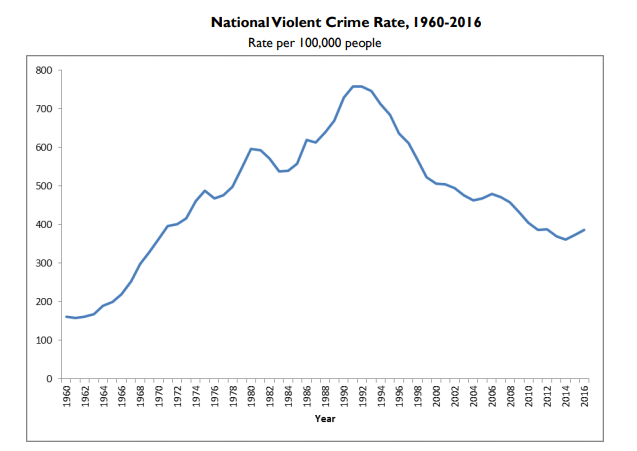There are many crimes in the world as well as those that considered as violent. They mean infliction of harm to human life or health and are divided into several types. FBI allocates the following: rape, aggravated assault, murder and nonnegligent manslaughter, and robbery. To understand whether law enforcement agencies cope with a fight against them, criminal data is gathered. Although statistics show the general crime recession for long years, recent abuse of police of the power and exaggerated perception of crimes by people do not inspire a sense of security to the population.
The FBI on its official website provides data on crimes. For example, in the Five-Year Trend Violent Crime Offense Figure, I was surprised by the sharp increase in crime in 2014-2016 (“Violent Crime,” 2017). An additional search showed that this is the first such quick jump in the long decline period since the beginning of the 90s (James, 2018). According to the Washington Post, the exact reason for the increase in violent crimes is unclear, but there is a theory that this is Ferguson Effect (Berman, 2016). It is associated with the murder of a teenager named Ferguson by a representative of law enforcement agencies and protests raising on this ground. Forensic scientists believe that the theory about this effect influence is not correct.

Recalling the events of the past year, it is difficult to say about decreasing crime. This opinion is closely related to the already mentioned abuse of law enforcement power. The new murder – of George Floyd in Minneapolis – did not just provoke an angry reaction from citizens but also significantly affected the population’s feeling of security. Such a cruel crime from people from whom the public usually expects protection significantly undermines the police’s reputation and can cause a sense of permissiveness.
According to Crime in the United States by Region, Geographic Division, and State (2017) and Crime in the United States by Metropolitan Statistical Area (2017), a decline or rise in crime can be observed in various regions. For example, the national level of violent crime has declined, although it has risen in the Midwest and West. In all areas, the number of rapes increased, but in almost all the West, the number of murders decreased. Moreover, the number of cases of all crimes has increased in the West.
Often, the perception of crimes is vastly exaggerated compared to reality – the decline is not as noticeable as growth. This difference affects the comfort of an individual’s life – amplified perceptions of violent crimes make them more frightening. However, it should be noted that the absence of fear can lead to excessive carelessness. The main reason for the difference in perception and reality is information and how people receive it. News about adverse events spread faster on television and the Internet than the positive ones. Moreover, they find a more vigorous response in people’s emotions, causing them to experience stress, and tacking into an account that the news arrives several times a day, this stress becomes constant. Reports on law enforcement agencies’ success are transmitted not so brightly, but more often in the form of official statements and facts, which also does not contribute to their memorization and vivid perception.
Criminal data is essential for informed public administration and resource management. First of all, criminal statistics can be seen as reflections of the real crime rate, something that needs to be looked at more closely. Secondly, the data also reflect the effectiveness of the work of law enforcement agencies, which can be used not only to study crime but also to evaluate the existing law enforcement system. Thirdly, statistics contain information on victims and objects of crime, which allows assessing the damage that crime causes to society. In this case, limited resources will be directed precisely to combating what causes the most significant harm. Misstate of data can be beneficial to law enforcement agencies if they want to hide their unsuccessful work or do not want to intimidate the population.
References
Berman, M. (2016). Violent crime and murders both went up in 2015, FBI says. The Washington Post. Web.
Crime in the United States by Metropolitan Statistical Area, 2017. FBI: UCR. Web.
Crime in the United States by Region, Geographic Division, and State, 2016–2017. FBI: UCR. Web.
James, N. (2018). Recent violent crime trends in the United States. Congressional Research Service, 45236. Web.
Violent Crime. (2017).FBI: UCR. Web.